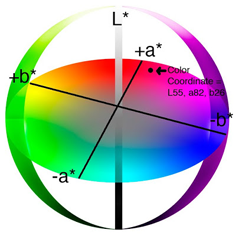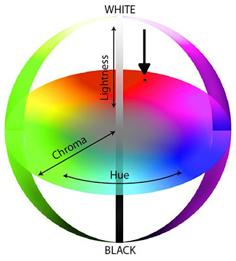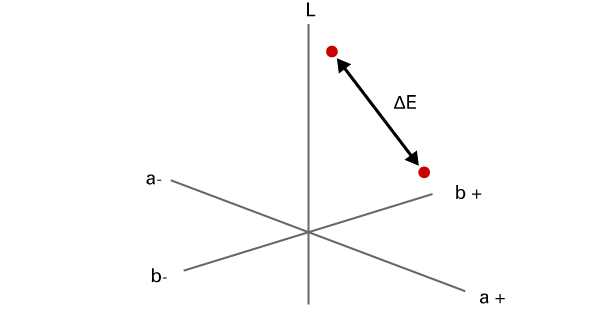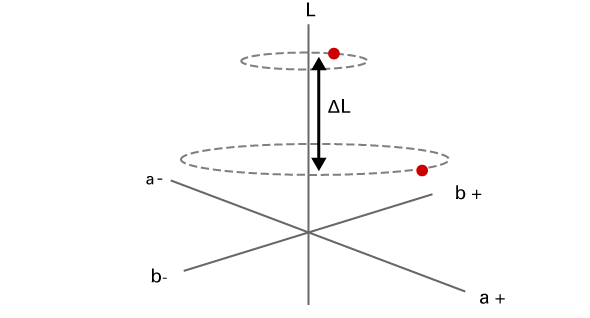

Color differences are the differences between the requested colors and reproduced colors. These color differences can be caused by factors such as printer environment, printer condition, printer gamut, media, and output profile. This topic explains how PRISMAsync compares and represents color differences.
Requested colors, printed colors and measured colors can all be defined with three numerical values. These three numerical values form together a three-dimensional color space. This makes it possible to calculate color differences by calculating the distance between two colors in a color space. For example between a requested color and the reproduced color.
The Commission Internationale d'Eclairage (CIE) offers the following CIELAB variants to define a color space:
CIE L*a*b* (CIELAB), in which:
L* represents the lightness (from 0 to 100)
a* represents the green to red axis (from -128 to +127)
b* represents the yellow to blue axis (from -128 to +127)
 CIE L*a*b*
CIE L*a*b*CIE L*C*h* (CIELCh), in which:
L* represents the lightness (from 0 to 100)
C* represents the chroma or color saturation, represented by the distance from the lightness axis (from 0 to > 100 at the edge)
h* represents the hue or color, represented by the angle with respect to the a-axis (from -180° to +180°)
C* and h* are calculated from the a* and b* coordinates of the CIE L*a*b* model. The same color is thus defined in two different notations: CIE L*a*b* and CIE L*C*h*.
 CIE L*C*h*
CIE L*C*h*
The CIELAB color space is device-independent and based on how humans perceive color differences. These are the main reasons why PRISMAsync uses the CIELAB color space to indicate color differences using the color metrics described below.
The most general CIE metric to express the difference between two colors in CIELAB is Delta E. PRISMAsync Print Server uses two variants of Delta E:
Delta E 1976, △E76, based on the calculated distance between two colors.
Delta E 2000, △E00, based on the calculated distance between two colors and the human perception of color differences.
 Difference between two colors in CIELAB
Difference between two colors in CIELAB The following Delta E00 range illustrates how the values of Delta E may be interpreted for a specific color evaluation.
Delta E00 smaller than 1 is not visible by humans.
Delta E00 between 1 and 2 is visible through close observation.
Delta E00 between 2 and 10 is visible at a glance.
To indicate more color difference information than the total color difference Delta E, the hue error △H (Delta H) is used.
You can imagine Delta H as which color difference is left over when the lightness and the chroma differences are ignored.
△L (Delta L) is the lightness difference between the two colors. |ΔL| is the absolute value of △L (Delta L).
The weighted |ΔL| puts more emphasis on the color differences for light grays, where the K value is lower than 50%. The goal of weighting is to reduce the importance of the lightness factor for very dark grays. Humans usually do not identify errors in the very dark gray color area. This weighting definition is in accordance with the IDEAlliance G7 specification.

Close to the gray axis, in other words for near neutral colors, the usage of Delta H is not appropriate enough. Instead, the usage of the △Ch (Delta Ch) metric is proposed.
The metric that is called chromaticness can reveal gray balance errors.
The weighted ΔCh puts more emphasis on the color differences between composite grays, where C is lower than 50%. The goal of weighting is to reduce the importance of the gray balance for very dark grays. These dark grays errors are difficult to handle and are usually printed with black toner. This weighting definition is in accordance with the IDEAlliance G7 specification.